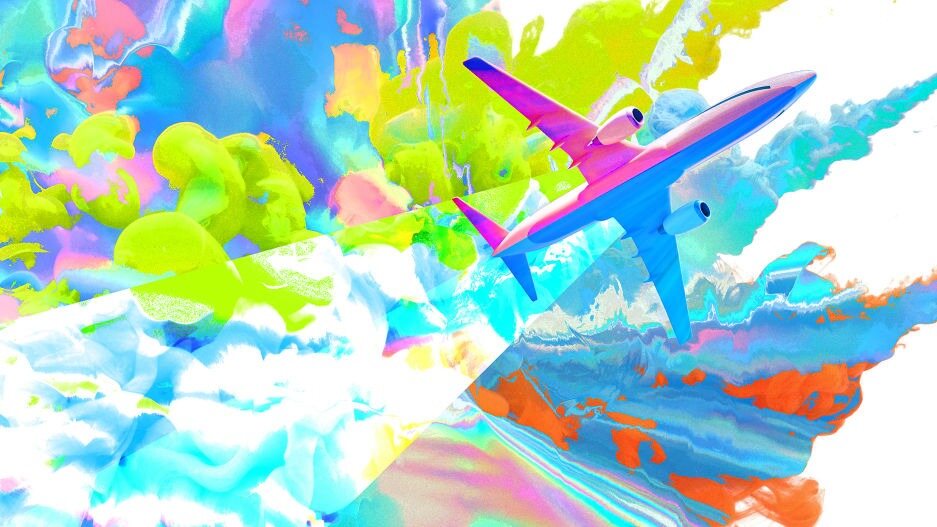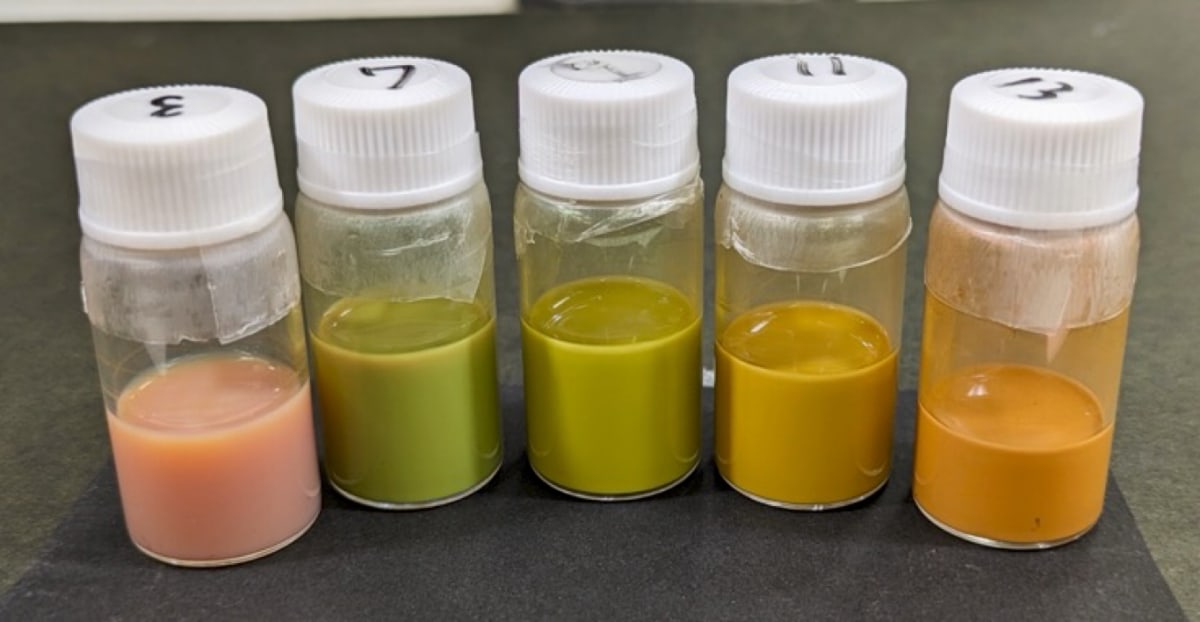- | 9:00 am
This new nanoparticle paint could make planes lighter, saving billions of dollars and tons of CO2
It weighs a mere 10% of traditional paint, offers brighter colors, and doesn’t fade.

Fujii Minoru and Sugimoto Hiroshi believe they can change the world one paint job at a time. These material scientists at Kobe University have discovered a new substance that can cover a surface with any bright color but use only 10% of the weight of traditional paint. As Sugimoto explains in a press release, “We can apply it to the coating of, for example, airplanes. The pigments and coatings on an airplane have a weight of several hundreds of kilograms. If we use our nanosphere-based ink, we might be able to reduce the weight to less than 10% of that.”
These nanospheres are almost-invisible silicon crystals that, according to new research published in the peer-reviewed journal ACS Applied Nano Materials, reflect light in such a way that can cover a full spectrum of vibrant, lasting colors.
At the heart of their discovery is the simple scientific fact that color is not just about what light is absorbed but also about what light is reflected. Traditional pigments work by swallowing certain wavelengths of light, leaving us with the colors we see. Over time, though, these pigments tire, like the design of a poster faded by sun.
NATURE SHOWS ITS TRUE COLORS
Nature shows us that there is another way to obtain bright colors that persist through time, like the iridescent sheen of a butterfly’s wing or the vivid plume of a peacock. This is called structural color, which basically manipulates light at the nanometric level to produce color.
This is the key to Fujii and Sugimoto’s breakthrough. Sugimoto says that the high reflectance of the nanosphere—despite the small coverage of the surface—“is due to the very large scattering efficiency” of these silicon nanocrystals. “The requirement of a very small amount of silicon crystals for coloration is an advantage in the application as a color pigment,” he says.
Fujii says that this work follows previous research since 2020, when they first achieved the precise particle size control to obtain the exact size of nanocrystals they wanted. Since then, the team has developed “colloidal suspensions of spherical and crystalline silicon nanoparticles,” he says. Colloidal suspension is what makes the actual paint, basically a stable state in which the nanoparticles remain mixed with the liquid that supports them, without separating. This is a crucial requirement to create usable paints.

The nanoparticles, they explain, generate color scattering light through a phenomenon called Mie resonance. “[This] allows us to develop structural color inks,” Fujii explains. Just how an audio engineer can control the pitch of a note by changing the shape of the waves, the team can shift the color these nanocrystals reflect by manipulating their size. Smaller particles produce blues and violets, while larger ones reflect bright reds and oranges.
But the real magic of their invention, they say, is the consistency of the color. While traditional structural colors like those displayed by some animals change depending on your viewpoint, these silicon nanospheres keep the same color from any angle.

THE WEIGHT OF THE MATTER
The advantages of the invention don’t end in their brightness, durability, or consistency. The low weight is the biggest factor that can save so much money in so many industries. As the researchers explain: “A single layer of sparsely distributed silicon nanoparticles with a thickness of only 100 to 200 nanometers shows bright colors but weighs less than half a gram per square meter.”
The reason is that these nanospheres have an extreme light-scattering efficiency. This means that they shine brightest when they stand apart, so they don’t require as much density as traditional pigments.
Consider the implications in an industry like aeronautics, where every single ounce on a plane, even a sugar packet for your coffee, has an effect on fuel consumption. When you multiply the weight of something tiny like a sugar packet by the number of units of that thing inside a plane by the number of airplanes with sugar packets by the number of flight hours, soon you end up with millions of pounds of fuel spent worldwide so you can have sweet coffee inflight.
Now imagine the weight of the paint covering an airplane. It may seem insignificant, but the effect can be staggering to both the cost of the flight and the millions of tons of CO2 produced.
The paint on an aircraft, while essential for protection and branding, is not just a layer of color. It must be lifted with every takeoff, carried through every mile, and brought back to earth with every landing. Consider your typical Boeing 777, one of the most popular wide-body airplanes in the world. Using this new nanoparticle paint, each 777 would shed 450 kilograms. That’s the weight of a grand piano in paint alone.
While this might sound trivial for a machine that weighs more than 300 tons, consider the bigger picture. In the course of a year, a typical 777 consumes about 168,750,000 kilograms of fuel. With this new nanoparticle paint, each aircraft would save almost 76,000 kilograms of fuel annually. This translates into a reduction of approximately 239.2 metric tons of CO2 per plane per year.
Now imagine a carrier with a hundred 777s in operation. Annually, this fleet could save about 7,593,750 kilograms of fuel, translating to a CO2 reduction of about 23,920 metric tons. If we peg the price of aviation fuel at around 80 cents per kilogram, the savings amount to roughly $75,937.50 per aircraft per year. For our hypothetical fleet of a hundred planes, this accumulates to a whopping $7.59 million in annual savings.
But let’s zoom out further, to the skies of the United States, home to thousands of commercial aircraft. If even a fraction of these planes adopted the technology, the savings in fuel costs and CO2 emissions would be monumental. We’re talking millions of dollars saved and tens of thousands of metric tons of CO2 averted annually.
Globally, the impact could scale even higher. With more than 20,000 commercial aircraft in the skies worldwide, the adoption of nanoparticle paint could translate into savings of hundreds of millions of dollars and a significant stride toward a greener, more sustainable future in aviation. For an industry already obsessed with saving every single pound to save every possible penny, this paint will undoubtedly be an attractive proposition. Now we need to see it evolve into a real industrial product that can be applied on airplanes—and everywhere else.






































